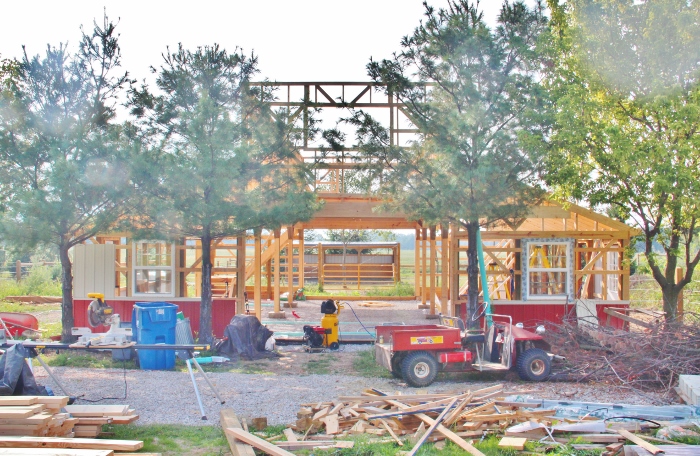Pt. 6: Green Lessons We Learned
by Mark P. Dangelo

It has been nearly two years since we finished our green equestrian facility. And, like most things, we learned some things only in hindsight as we watched segments of this unique venture either deliver or fall short of our expectations. In the business world, we label these moments of clarity as Lessons Learned. The following include our personal lessons and things we would improve on.
Foundations: This is one area where I wish I would have spent the extra money and utilized poured walls for footings and wall rises rather than use a traditional pole barn design. While we created a foundation that will likely outlast the life of other parts of the structure, our extreme engineering use of 6 by 6 structural poles every four feet (common barn building practice is 8 foot centers using 4 by 4’s) resulted in interior finishing challenges. Additionally, in our climate of huge temperature swings, we would have experienced fewer winter issues, especially around doors and large openings, even with pillars below four feet from grade.
Structure: While we utilized a standardized metal skin (containing a high percentage of recycled metals), the framing for this when compared to wood frames on 16 inch centers, presented build out adjustments. A traditional framed wall would have been stronger, especially if we inserted them between the vertical pillars, while giving us larger finishing options.
HVAC: Floor insulation is one thing we should have increased for our climate. Whereas we slightly exceed recommendations for buried rigid insulation, we should have used a stall floor design where we layered multiple layers of interlocking floor mats set into an on-site cast concrete frame. Digging the floors in the stalls two inches deeper than the rest of the building would have allowed for layering of recycled rubber and ample radiant blocking for rising cold.
Waste Management: Here we wish we would have constructed the composting centers (a three bin design) first before spending the year building the green barn. Horse waste is always there and does not stop for construction. By taking care of solid waste first and then incorporating the gray and dark water collections, we would have saved some rework, money, stop-starting and consternation.
Power and Water: We spent a lot of time preparing for solar, only to wait due to costs and technology for our climate (and the hostile climate within the barns). While we focused on making sure our efficiencies were high (LED, instantaneous hot water heaters, etc.), we could have saved time and money by deferring solar for a later date. Our water design originally called for a cistern first (in ground) and we deferred this for costs (over $5K). This is still on our list of improvements. It is a break-even proposition for our climate, but something very positive for our environment.
Stalls and Care: The lesson learned here was about keeping air flows in between stalls within the structure. Although we anticipated the necessity of front to back entry, ventilation, and use, we did not appreciate the benefits of opening up the half walls between the horses for cross breezes. This added to cleaning frequency of walls, higher use of ceiling fans and a surface that allowed insects to congregate during the heavy fly season.
Fencing and Paddocks: Since we avoided the overuse of wood by using coated wires horizontally spaced every 9 inches, we underestimated the reality that, for a horse, the grass is always greener on the other side of the fence. This required us to retrofit two electric lines between the existing runs. Why two? While the adults were conditioned to respect electric fences colts are another matter. They knew which paddock had the lower fences even when the adults did not. The installation of electric from the start would have saved time adjusting the seven wire runs , over and over.
It has been my pleasure sharing our family’s experiences with everyone over the last year. There are many changes constantly advancing the field of green building. These new solutions will likely provide a more rapid incorporation into blueprints, without the time and effort we spent. Our building adventures move forward as we are now designing new barns to house hay equipment as well as a riding arena. We will apply our experiences and Lessons Learned to these new structures in the future. In closing, I will borrow a phrase from my daughter who is an architect: Every building in this world should earn the right to exist by giving back to the environment more than it takes.
Published in November 2015 Issue
Mark Dangelo lives in Ohio with his wife Elisabeth, their children and their horses. He is a widely published business author and global advisor (www.mpdl2c.com), and his wife is a very successful professional photographer specializing in digital imaging, photo (re)construction, event coverage and magazine shoots (www.shootforthemoon.photography). Additionally, they are farmers and do their best to leave few footprints behind them as they value their time with their animals and the environment. Beth and Mark also provide assistance to other equine families and businesses seeking to benefit from their experiences with sustainability and holistic care for their horses and animals.





